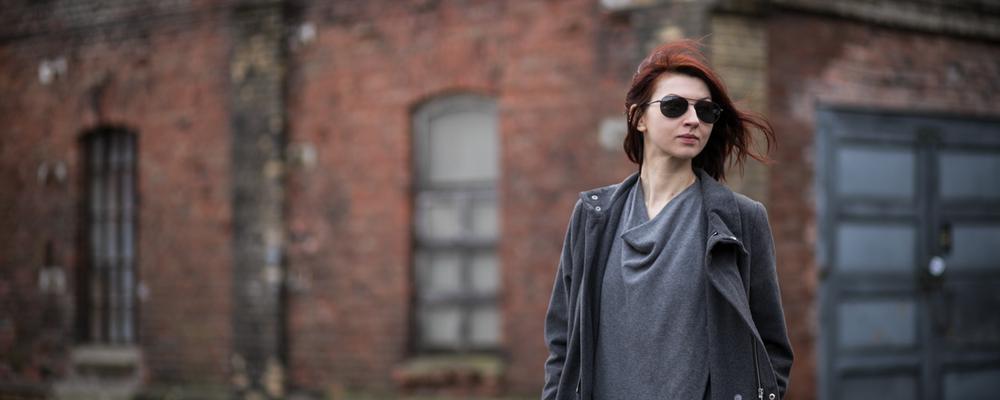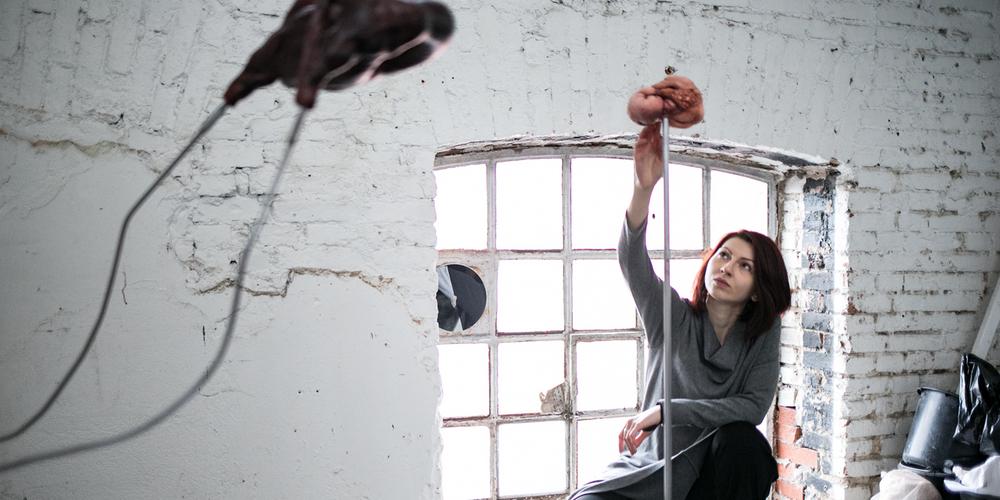
- Home
- News and events
- Find news
- Maja took the chance - today she is working with art
Maja took the chance - today she is working with art
For a very long time there was no place for art in Maja Sikorska’s life. Now it’s her way of being. She has found her own style now, in part thanks to her time at HDK-Valand and to several exhibitions. With sculptural forms that suggest the human body, she turns her focus inward. “I’m fascinated by the tactile, intuitive and emotional,” she says.
In the old Lyckholm Brewery on the Mölndal River, a number of different artists have found their place. One of them is Maja Sikorska. Inside one these buildings, which are threatened with demolition, where the brewery’s old machinery stands side-by-side with sculptures, music studios and painters’ easels, Maja has her studio. The air here is cold and damp.
“Unfortunately, I can’t be here so much at the moment because my papers get destroyed by the damp that fills every room in the wintertime,” she says.
Exploring relationship between body and psyche
But there are exceptions. In a glassed-in room that may have been part of the core of the factory, the portable heaters are working hard. On one table lies Maja’s latest work, which will soon have its own exhibition.

It is made up of sheets of white paper with thin ink lines that create rounded forms that seem to be alive. They crouch, sway and stretch out. The forms cannot be identified, and yet they spark recognition in us, and other feelings as well.
Maja categorizes these pieces as belonging to the biomorphism movement in art, which is based on the forms of the natural world and the human body.
“When I read about Jean Arp, one of the leaders of the development of biomorphism, I realised that I think more or less like a German-French man who lived more than a hundred years ago,” she says with a smile.
The motifs have emerged from an intuitive working method in which the movement of the artist’s hand is intimately linked with her thoughts and feelings.
“I follow the forms with my body,” she says. “Creating is not a product of thinking for me. It is an experience in which I explore the relationship between the body and the psyche.”
The Road to HDK-Valand
Maja says that art is her way of interacting with the world and with herself. But it hasn’t always been that way. For a long time, she felt like she was instead standing on the outside of the world and looking in. And she longed to be able to devote herself to art. But being raised by a single mother, growing up in post-war Poland, she understood the importance of prioritising an education that could provide her with safe employment.
“And reducing my art to a hobby would have felt like I was only partly allowed to be myself – it would have been too painful. So I didn’t even consider that,” says Maja.
Until one day at the end of 2010, when a friend pointed out that she was unhappy.
“I was studying at the university at the time, and he was in the art school. That made me realise that it was actually possible to choose art. I made the decision from one day to the next. I let myself be who I really am.”

She applied and was accepted to the Dômen Art School, and then to HDK-Valand’s undergraduate programme in fine art.
While she studied, she continued working at Megalodon Creations, which produces large exhibitions of various kinds of animals, from dinosaurs to ice age species.
“The job at Megalodon Creations has been a fantastic school where I could get to know and work with different materials and techniques,” she says. “That’s where I acquired my expertise in craftsmanship.”
Maja Learned to Talk About Her Art
She found studying at HDK-Valand to be more theoretical – for both better and worse.
“We learned to analyse, verbalise and put our art into a context,” she says. “But that didn’t always suit me, since I’m interested in exploring more tactile, emotional and intuitive values.”
At the same time, she thinks it was just this analytical approach that has given her a couple of important tools for life as a working artist.
“I learned to talk about my art. For example, today I have no problem writing grant applications and the like. In the school’s own gallery, I also got valuable experience of what it’s like to show my work.”
That is something she’s had a lot of use for. Since graduating from HDK-Valand, she has had three solo and six group exhibitions. In the latest, called Familiar Unknown, her soft, organic forms provoke visitor’s associations. Or as Maja’s kindred spirit, Jean Arp, said, “A tree has already become a tree. Let us make a form that could become a tree. That is much more interesting – not to depict something that already exists, but to think of the direction it might take.”
“That’s how I think,” says Maja. “I follow the creating wherever it leads me. I start in one place, let it find its form, and then trust that others will continue on and fill in with their imagination. I love the potential!”
By Åsa Rehnström
